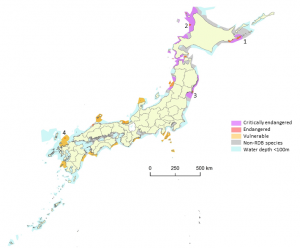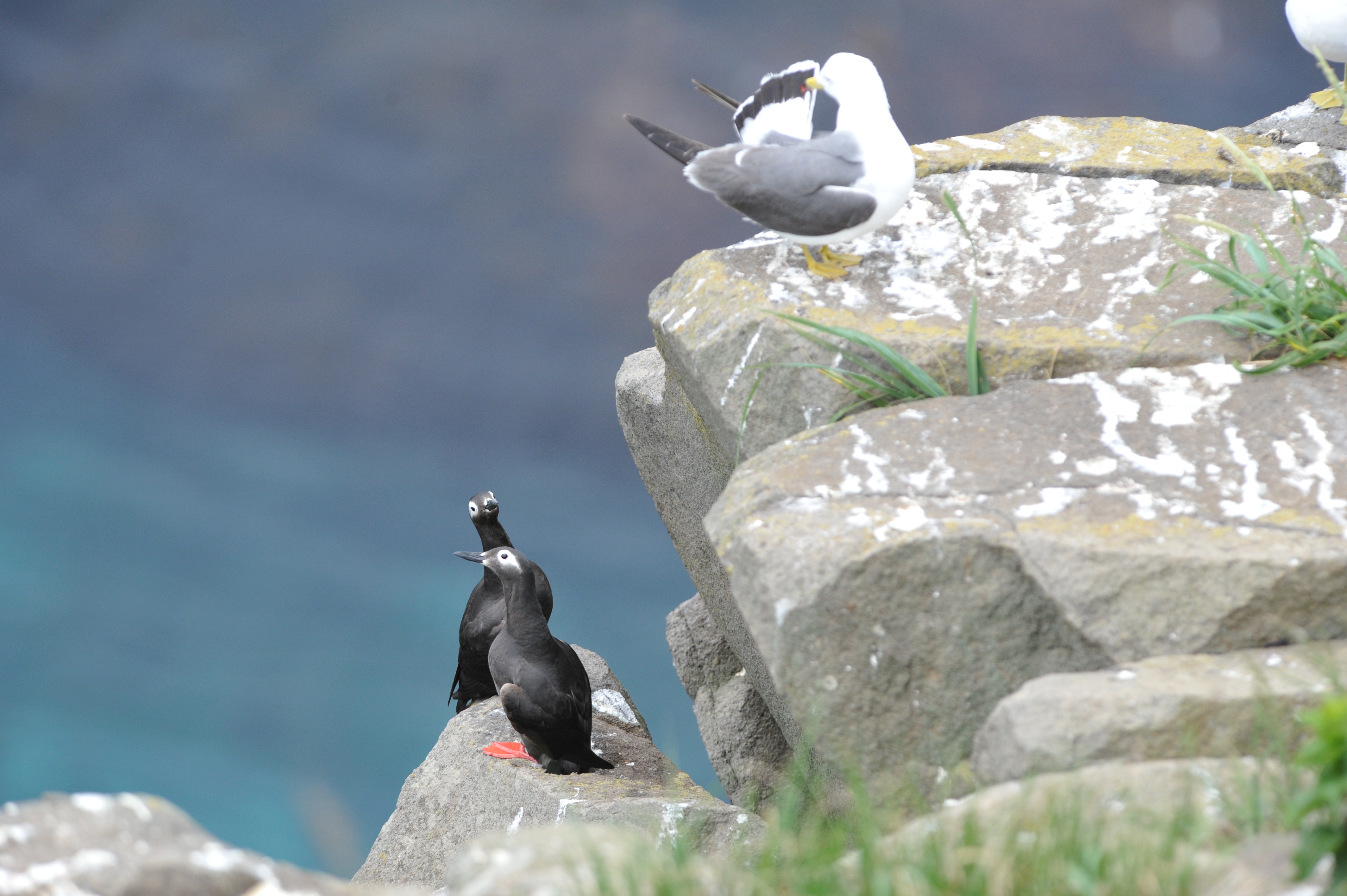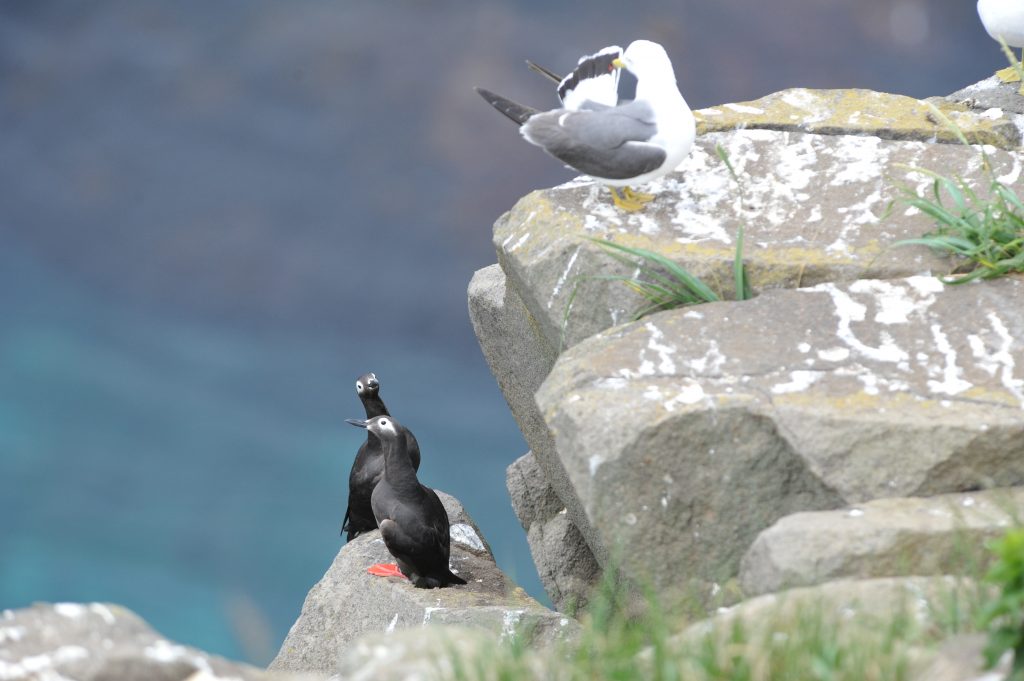In March 2020, BirdLife International and Wild Bird Society of Japan have published a nationwide-scale hotspot map of seabird bycatch in gillnet fisheries in collaboration with a seabird scientist from the University of Tokyo. The map suggested four areas, including Eastern and Northwestern Hokkaido, as hotspots for seabird bycatch in gillnet fisheries.
Bycatch in fisheries has been known as one of the biggest threats to seabirds. According to a global review 1, approximately 400,000 seabirds are being killed in gillnet fisheries every year. However, no effective mitigation measures have been established.
Based on the global review, 10 diving seabird species breeding in Japan are considered susceptible to bycatch in gillnets (Table 1). Using colony data and foraging distance information, we estimated foraging areas of each species. Through in-person interviews with fishers and local fisheries associations in the areas where gillnet bycatch risk was assumed to be high, we learned water depth is an important factor to identify bycatch risk in gillnet fisheries. Given that set-gillnets used in Japan are mostly bottom-set, and diving seabirds breeding in Japan usually would not dive deeper than 100 m, the bycatch risk would increase in shallow water less than 100 m depth. By layering seabird colonies and foraging range with areas with water depth of <100 m on a map, we identified areas where diving seabirds and gillnet fisheries overlap in Japanese waters (Figure 1).
Based on the map and annual fish catch information collected by the Ministry of Agriculture, Forestry, and Fisheries of Japan, four areas where bycatch risk is expected to be high have been identified.
1) Eastern Hokkaido
There are many breeding colonies of seabird species threatened with local extinction, including Red-faced Cormorant, Pelagic Cormorant, Spectacled Guillemot, and Tufted Puffin in this area. Water depth is <100 m in the vast area along and off the coast. Annual fish catch in gillnet fisheries in this area is very high.
2) Northwestern Hokkaido
There are breeding colonies of Pelagic Cormorant, Common Murre, Spectacled Guillemot, and Ancient Murrelet, and a very large colony of Rhinoceros Auklet in this area. Water depth is <100 m between Teuri Island and the coastline of mainland Hokkaido.
3) Coastal area of Miyagi prefecture in the northeastern region of Honshu
The southernmost breeding colony of Rhinoceros Auklet is located, and Ancient Murrelet is also most likely breeding in this area. Water depth is relatively shallow (<100 m) in Sendai Bay. Annual fish catch in gillnet fisheries is also significant in this area.
4) Northwestern Kyushu
There are breeding colonies of globally threatened Japanese Murrelet on islands in Fukuoka prefecture. Water depth around those islands is relatively shallow (<100 m). Annual fish catch in gillnet fisheries in this area is significant.
Although we have identified these potential hotspots, data on seabird bycatch in Japan remain severely limited. As a next step, we will focus on data collection in the high priority areas identified in this project to find ways to mitigate seabird bycatch in gillnet fisheries. Collaboration with local fishing communities is essential to better understand the issue. Also, developing practical and effective measures is urgently needed.
We have been working with fishers in the town of Haboro in northwestern Hokkaido to conduct at-sea trials of potential mitigation measures (see details in Mitigation Measure Trial Report). We plan to continue our community-based approach in Japan to start systematic data collection and further mitigation trials for seabird conservation and sustainable fisheries.
Table1. Species and conservation status of diving seabirds breeding in Japan and considered particularly susceptible to bycatch in gillnet fisheries.
| Species | Conservation status in Japan’s Red Data Book |
| Great Cormorant | Least concern |
| Japanese Cormorant | Least concern |
| Red-faced Cormorant | Critically endangered |
| Pelagic Cormorant | Endangered |
| Common Murre | Critically endangered |
| Spectacled Guillemot | Vulnerable |
| Ancient Murrelet | Critically endangered |
| Japanese Murrelet | Vulnerable |
| Rhinoceros Auklet | Least concern |
| Tufted Puffin | Critically endangered |

Figure1. Foraging areas around breeding colonies of 10 diving seabird species, overlapping with areas with water depth of <100m. Color codes of foraging areas represent conservation status in Japan’s Red Data Book (RDB). Numerical identifications correspond with descriptions above of the four areas.
Information of this news article provided by BirdLife International and Wild Bird Society of Japan.
*Hotspot map report
https://www.wbsj.org/nature/kyozon/marine-bird-fishery/img/report-20200327-2.pdf
*Mitigation measure trial report
https://www.wbsj.org/nature/kyozon/marine-bird-fishery/img/report-20200327-1.pdf
Original Press release by Wild Bird Society of Japan in Japanese (27 March, 2020)
海鳥と漁業の共存のために 刺し網漁による海鳥混獲リスクマップを作成
Hiroko Okamoto (Wild Bird Society of Japan), Yasuko Suzuki (BirdLife International)
Inquiry on the hotspot map of gillnet bycatch, please contact:
Wild Bird Society of Japan Email: hogo@wbsj.org
Reference:
1. Zydelis, R., C. Small and G. French. 2013. The incidental catch of seabirds in gillnet fisheries: a global review. Biological Conservation 162: 76–88.






